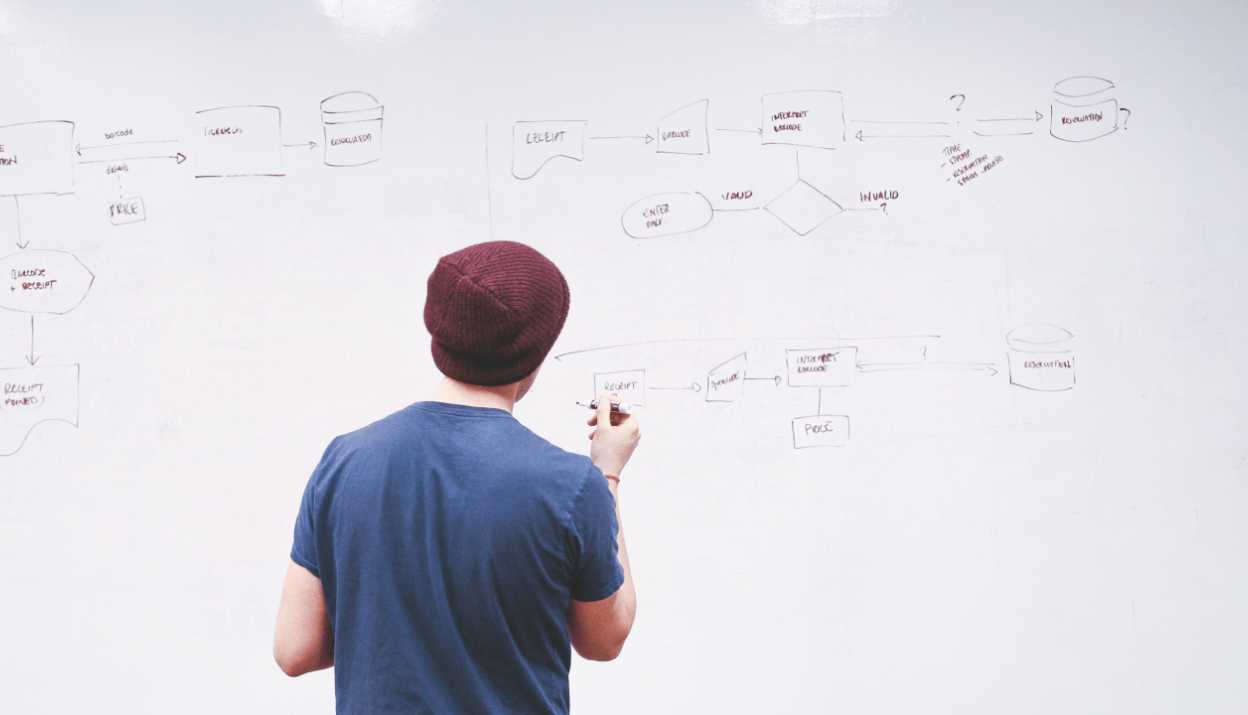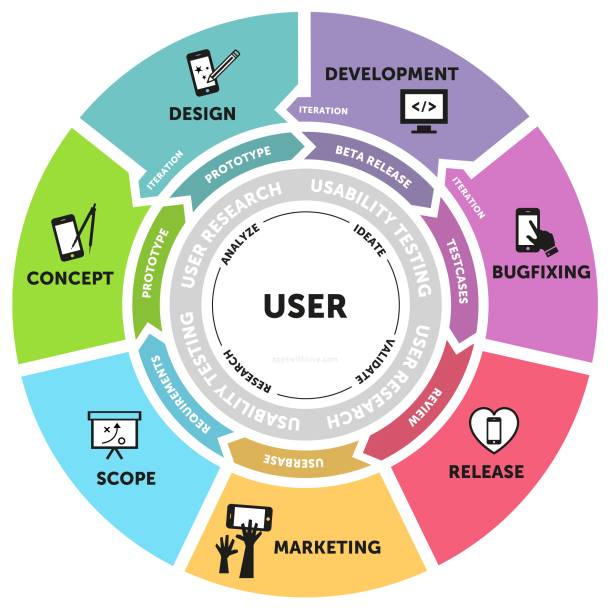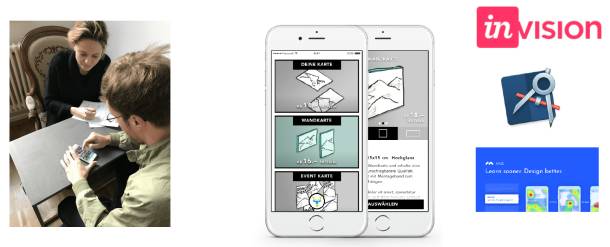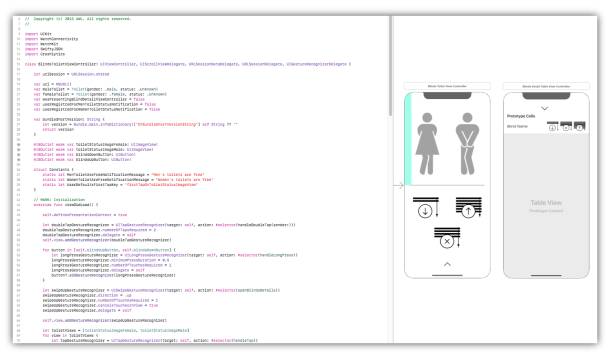It's a long and sometimes rocky road from the initial idea for an app to the finished app. Especially if you don't have a clear vision and goals or a strong and experienced team. Find out what you need to watch out for to make sure your software project is a walk in the park, not a horror trip.
APPS WITH LOVE - DEVELOPMENT PROCESS
In this blog post, we set out the development process we at Apps with love have followed to successfully develop and launch more than 120 apps over the past 7 years.
WHICH PROBLEM DO I WANT TO SOLVE?
A project usually starts with an idea of how to solve an existing problem or satisfy a need. Someone comes up with a hypothesis, such as the one for Tinder - "A single photo is enough to form an opinion about someone else in a second" or for inlingua - "many of our existing customers would prefer flexible language courses to standardised ones".
We describe this phase of defining the problem, developing a hypothesis, and subsequently drawing up the initial product requirements pragmatically as the "Scope". The aim is to define a solution for the problem and thus to achieve "problem/solution agreement". The best way to test whether you have found a good solution for an existing problem is with a target group that has been defined in advance. This initial clarification phase also requires developing or defining a clear vision and goals for the project. Only those who have a clear vision know where the path should lead.
CONCEPT DEVELOPMENT AND VALIDATION
Once a clear picture of the underlying problem and a corresponding hypothesis have been established, they can be validated with the target group. We develop wireframes and screen sketches showing possible solutions. The functional design and information architecture are worked out in this phase. We help our customers by offering various services such as rapid prototyping and user research activities. Read more about this in the blog post "user research in app development".
Once the hypothesis (or hypotheses) has been validated by the target group, we are ready for the next step in the software development process. It is important to note that a customer survey may also reveal that the hypothesis/es cannot be confirmed and that we should either abandon the project or develop a new hypothesis. It sometimes takes several iterations and feedback cycles to reach problem/solution agreement.
SCREEN- AND INTERACTION DESIGN
After we've drawn up the concept and validated the hypotheses, colour comes into play. The design of the app is an important part of the user experience. The perfect interplay between design and development is becoming increasingly important. The design of icons, pictograms, and animations, which shape usability and the user experience, follows design guidelines. As experts, we do not always know which design offers the target group a better experience and ideal usability, which is why we involve end users and our customers heavily in the design process. We come up with the right look & feel for the digital products through several iterations using workshops with the customer and end users and larger usability tests (online or in focus groups).
AGILE APP DEVELOPMENT AND TESTING
In order to start the development of the backend (CMS, interfaces, feeds) and the frontends (apps on the smartphone), exact user stories, developer specifications, and acceptance criteria are required. These developer specifications contain all the designs as well as the general non-functional and detailed technical requirements for the applications and peripheral systems. Especially for larger projects, exact specifications are only drawn up for the next sprints and not for the entire scope, because new findings and changes can and will of course arise during implementation, which will change the initial scope. The scope (for the entire project) is divided into sprints that are as far as possible of equal size in order to implement the development agilely and in small steps. We discuss these specifications with our customers per sprint and jointly define the acceptance criteria for each requirement in order to create the prerequisites for optimum development implementation. After each sprint, the product is tested in its current state of development and sprint reviews are carried out. Sprint reviews enable a continuous dialogue with the customer (project team) and offer the opportunity to optimise processes, communication, and development during the project.
AGILE DEVELOPMENT VERSUS THE WATERFALL PRINCIPLE
Our experience shows that every project is unique. There is not just one right project approach. We always recommend an agile approach for the development of new software. It does not make sense to implement larger software projects based on the waterfall principle. The scope is divided into sub-projects and sprints depending on the type and size of the project, so that the concepts and developed functions can be tested and improved during the development process instead of shifting all the testing to the end of the project. At the end of each sprint, the customer receives a testable version of the app, which is put through its paces both at Apps with love and by the customer. We thereby offer additional security and certainty for our customers by testing the usability directly with the defined target group in the respective target market and continuously incorporating the findings into the development. Depending on the customer's budget, goals, and expectations, such usability tests can take place in an in-house focus group, on the streets, via online testing, or even in a usability lab. Of course, it is important that such tests involve the actual target group for the product, and not just e.g. the product owners and project managers along with a few internal interested people.
Before the app is uploaded to Apple and Google for review, all insights, optimisation requests, and faults that emerge in the beta testing phase are implemented.
FINAL RELEASE, GO-LIVE, AND MARKETING
The app launch should be well planned. Often, important opinion leaders, media representatives, bloggers, and other stakeholders are given a non-public app release before the app is published in the app store, so that they can test the product and prepare their reports before the launch. It is also advisable to establish a user community during the development phase. You can find out more in the blog post "PRE LAUNCH APP MARKETING THROUGH USER RESEARCH AND COMMUNITY BUILDING".
It is important to prepare well for the app launch and to consider strategic measures as well. Sometimes it is a good idea to organise a launch event or to give an important medium exclusivity (pre-launch) for communications, if this is planned as part of the communication concept. It is very important that the marketing of the new app is not only planned in this last phase, but is prepared very early on so that targeted communication on this new product can be implemented on launch day and in the following weeks.
We recommend you start marketing the app as early as the concept phase. The following aspects should be optimised and planned for the launch:
Appealing, eye-catching app icon
Clear message that emphasises the emotional benefits of the app (not features!)
App store optimisation and the right keywords, titles, and descriptions for all target languages.
Top screenshots in all languages for app stores and social media
Explainer / viral video for the app
You should get positive ratings in the app stores as soon as possible
Good PR - the goal should be to generate as many clippings (articles in the press) about the app as possible.
Landing page, Facebook fan page, Twitter, & G+ should be used to generate backlinks and social buzz.
App review pages and influencer marketing (bloggers) increase the reach.
FACTORS FOR SUCCESSFUL APP DEVELOPMENT
Only apps with a big vision, a real added value, and a clear benefit for end users have a chance. That's why it is important to validate the hypotheses with a simple prototype in the target group before developing a new digital product.
The user experience (UX) is the key to success. Only apps that offer a good UX will be successful in the long run. You should not fall in love with the product, but with the users. Develop a user-centric product.
Less is often more. It is important to solve ONE problem properly instead of multiple problems at the same time.
End users should be involved in the development process where possible. This can be done with focus groups or online or in-house usability testing.
The app should be self-explanatory. Simplicity and comprehensibility are key.
A clear target group, a clear core message, and an effective communication strategy are essential for the app to spread rapidly. Without good app marketing, no one will find out about the product so no one will use it.
Personalisation, localisation (language), and contextualisation of app content and app store texts.
Good digital products can only be created with good teamwork and the right team. The digital agency and the project team should strive for and engage in very close collaboration. You need not only good programmers and designers, but also good business developers (growth hackers) and product managers.
Retention = growth. Your product can only be successful if it is used regularly and recommended by users. A Win/Win referral programme helps with organic growth and can create the necessary viral spread and strong user growth.
BUILD, MEASURE, LEARN - WE WELCOME ANY FEEDBACK
We also apply the lean start-up principle of "Build - Measure - Learn" to developing our own agile processes. We are constantly striving to exceed the expectations of our customers and end users and welcome any feedback on our way of working, as well as on our end products. If you have a digital project on the roadmap, we look forward to hearing from you at info@appswithlove.com.





